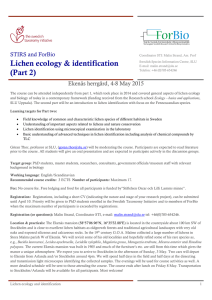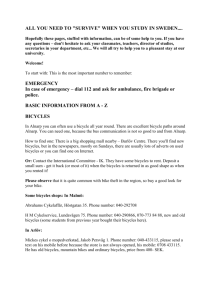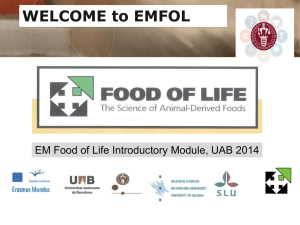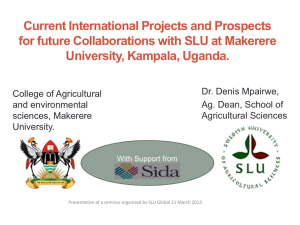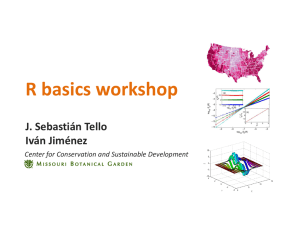Partnership Alnarp
advertisement
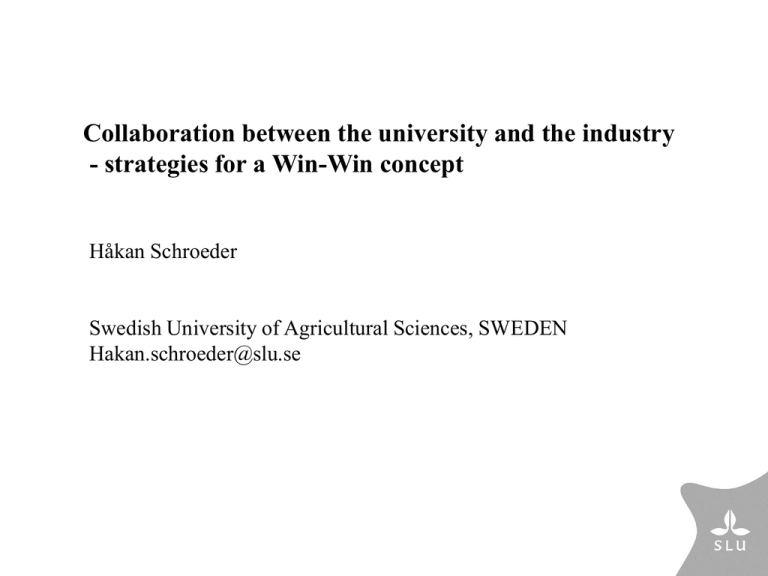
Collaboration between the university and the industry - strategies for a Win-Win concept Håkan Schroeder Swedish University of Agricultural Sciences, SWEDEN Hakan.schroeder@slu.se Collaboration between university, industry and society is being increasingly emphasised In order for universities to secure access to economic resources for research, increasingly strict demands will be placed on the benefit of this research for commercial or other societal development in the short and long term. The universities need to develop the capability of using the research knowledge for new products or services. three target areas for collaboration between the university and industry or the society Collaboration for: • knowledge development and growth, i.e. university participation in the knowledge and innovation system. • better education, i.e. dialogue between universities and the surrounding society on the content and scope of degree courses and external contacts by students during their education. • democratic development, i.e. the work of universities on communicating research for public education. Examples of collaborations tools from SLU Two examples of collaborations a the Faculty of Landscape, Horticulture & Agriculture (LTJ) at SLU • ‘Partnership Alnarp’ (http://partnerskapalnarp.slu.se). • ‘expansion in Horticulture’ (http://tillvaxttradgard.slu.se) Sveriges lantbruksuniversitet www.slu.se Sveriges lantbruksuniversitet www.slu.se Partnership Alnarp Interface between academic and commercial life Partnership Alnarp – facts • Partnership Alnarp (PA), which was started in autumn 2004, is a collaborative organisation between SLU and commercial businesses, authorties and organisations in the Southern Sweden region • About 80 members (companies and organisations) • By the beginning of 2010, 431 projects had been approved since PA started in 2004. 20-25 per year have been workshops and conferences with about 2000 participants. • total turnover for the projects has amounted to around SEK 100 million since the start, with SLU contributing approx. SEK 5 million per year. In addition to this funding, SLU bears the costs of coordination and administration (SEK 1.8 million in 2011). • The subject groups normally have an external chairperson. Partnership Alnarp - goals PA has the following area and action goals: • To contribute to the long-term sustainability of a landbased industry with its foundations in the production of food, raw materials for industry, bioenergy and ornamental plants. • To contribute to high quality research and education within the green sector. • To develop enduring and effective contact interfaces between participating businesses, universities and authorities. • To increase insights among other actors and the public at large regarding the significance and development and innovation potential of land-based industries. • To develop international partnerships. Partnership Alnarp - indicators for goal fulfilment Examples of indicators for goal fulfilment are that: • Partner businesses and organisations are developed through a change in behaviour that can lead to increased costeffectiveness and/or value added to goods or services provided. • Research and education at SLU is of high quality. • Research results are applied in practice. • Students are attractive on the employment market. • The level of competence within the sector is high. Bengt Persson, farmer:: The only hope for the future is through knowledge - new knowledge or better use of existing knowledge Sveriges lantbruksuniversitet www.slu.se Henrik Stridh, adviser: Five years ago, scientists in Alnarp were involved with what they thought was fun, usually something that were of little benefit to us. With Partnership Alnarp, it has become a big difference. Now the researchers are solving the problems we face within the horticulture industry and are keeping in regular contact with us.. Sveriges lantbruksuniversitet www.slu.se Anders Borgqvist, chairman Södra Sveriges Frö- och Oljeväxtodlare Partnership Alnarp is one of the stars of SLU. It is a very successful partnership that we fully intend to continue and expand Sveriges lantbruksuniversitet www.slu.se Partnership Alnarp - activities • Research projects in collaboration between SLU and partners • Meetings (conferences, seminars, workshops) • Student activities (mentoring, degree project) Evaluation questionnaire to members Question: How did the company first became aware of the existence of Partnership Alnarp? Answer: Contact with a named person Conclusion: If you want to start coop with business: employ well known people with huge network in the business! Q: Why member? A: Knowledge and networking C: Offer knowledge and networking Q: Main obstacles? A: Lack of time and geographic distance C: Time?, build local networks Sveriges lantbruksuniversitet www.slu.se Interviews with academics and students • • • • • Project leaders: The contact with industry is stimulating and fruitful Partnership Alnarp is viewed as a lubricant in the contact between research and the surrounding environment It makes the university known Many projects would never have come into existence without Partnership Alnarp Tendency toward relatively small projects Seminar organisers: • Very satisfied with the collaboration with Partnership Alnarp • Would like to see more members participating Sveriges lantbruksuniversitet www.slu.se • • • • Heads of department: All appreciated the closeness to the surrounding environment and the network Some, especially those with more basic research, were unsure about whether the funds available are being used most efficiently in this way Transparency very important The overall view was favourable Students: • The aspect they appreciated most was acquiring insights into industry and making contacts there • It’s good for academic staff to come into contact with industry • Students can receive help, financial and networking, with their degree projects and theses through Partnership Alnarp and this is very valuable Sveriges lantbruksuniversitet www.slu.se Conclusions • Partnership Alnarp a “success story”, a generator of growth and a brand creator for SLU, Alnarp • Networking, closeness and personal relations crucial • Attention to the role of science: firms and organisations usually favour short term problem-solving applied research, while scientists wish for long-term research • The trend is toward more collaboration between research/education and industry Sveriges lantbruksuniversitet www.slu.se Challenges in enhancing the utilisation of research results • The universities must continue to develop enduring networks and relationship that are based on mutual trust between the parties. • Leaders within academia must highlight the importance of collaboration with industry and society. • Documentation of measurable deliverables as a part of the academic qualification systems • A specific challenge in supporting innovation activities will be to identify forms for the commercialisation of research innovations if the researchers themselves do not want to bring the idea on to commercial level. • Supporting systems must be developed for resourceefficient utilisation of results, so that researchers can continue to focus on their research activities. Collaboration benefits for the academy University research and education can benefit from close collaboration with knowledge users in several ways. • External funding places demands for up-to-date and relevant research topics. Through close collaboration these research topics can be expanded. • University degree courses are exposed to competition through the increased mobility of students. Courses involving prospective employers are attractive since they improve the opportunities to get a job after graduation. • A well developed network and effective dialogue with actors within the industry and other sectors of society contributes to the external analysis that universities must prioritise in order to keep pace with a changing world with new challenges

